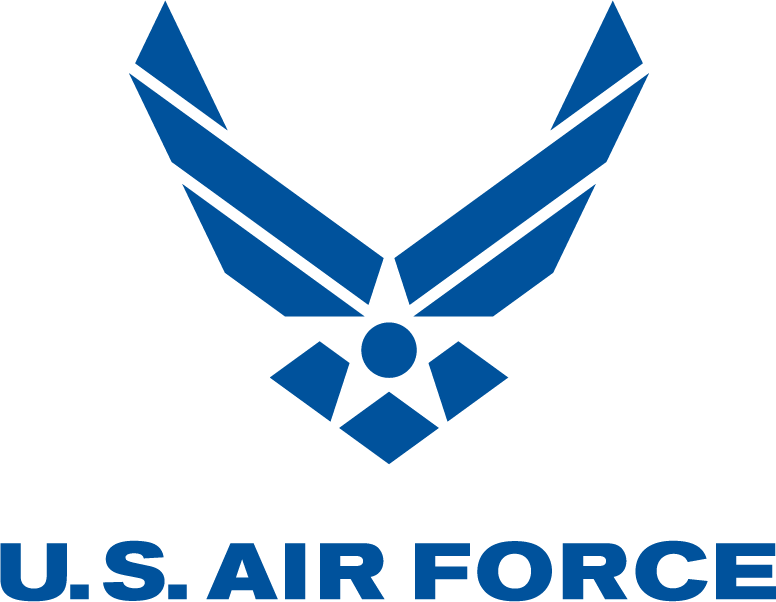
Every now and again we spotters have to accept that we won’t see a beloved friend around anymore. Well for those in attendance at the 2023 Australian International Airshow at Avalon Airport from late February until early March this situation was at the keyhole on the Northern end of the airfield.
Standing very proud among its other United States Air Force brother and sisters in arms was the large grey trijet known as the KC-10A Extender.
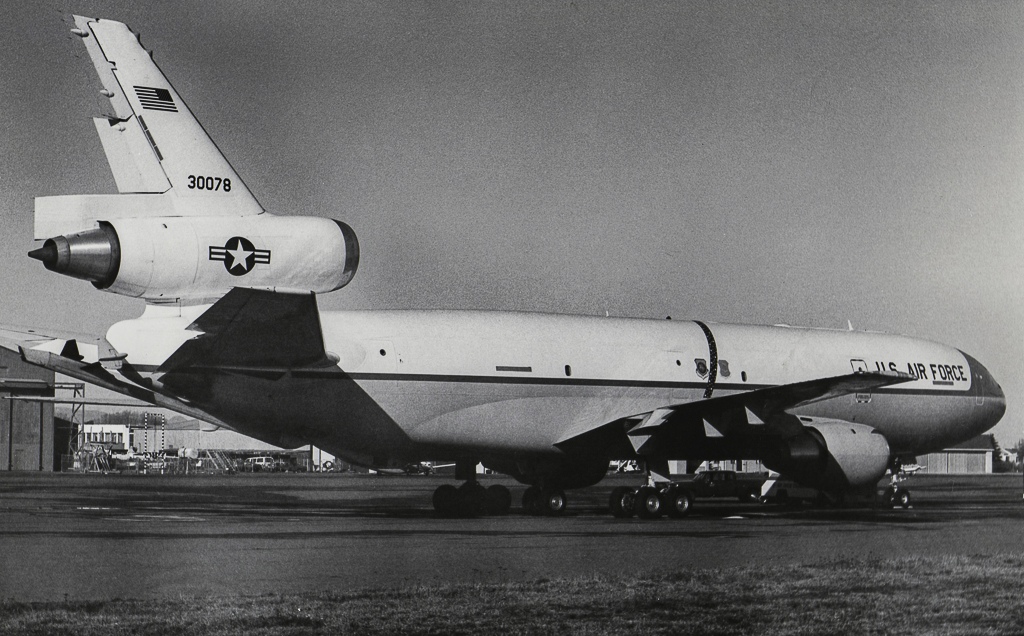
83-0078 at RAAF Williamtown after its delivery of RAAF Classic Hornets. (ASO Image archive)
Aircraft 83-0078, delivered to the Air Force on the 13th of December 1983, is now a 40-year veteran. Built at the McDonnell Douglas Factory in Long Beach, California. Avalon 2023 would be its last overseas mission before returning stateside and retiring into the ‘Boneyard’ at Davis-Monthan AFB in Arizona. 83-0078 is no stranger to Australia, having been photographed by the ASO team on two previous occasions. The first visit was in 1987 at Melbourne Airport and again some years later in 2011 at the Avalon Airshow.
In 1987 the aircraft was featured at Melbourne Airport supporting the USAF display team the Thunderbirds, and again some years later in 2011 at the Avalon Airshow. It’s most recent showing at the 2023 event is a bittersweet one.

McDonnell Douglas KC-10A Extender, 83-0078 seen here at Melbourne International Airport during the United States Air Force Demonstration Team ‘The Thunderbirds’ Australian visit in 1987.
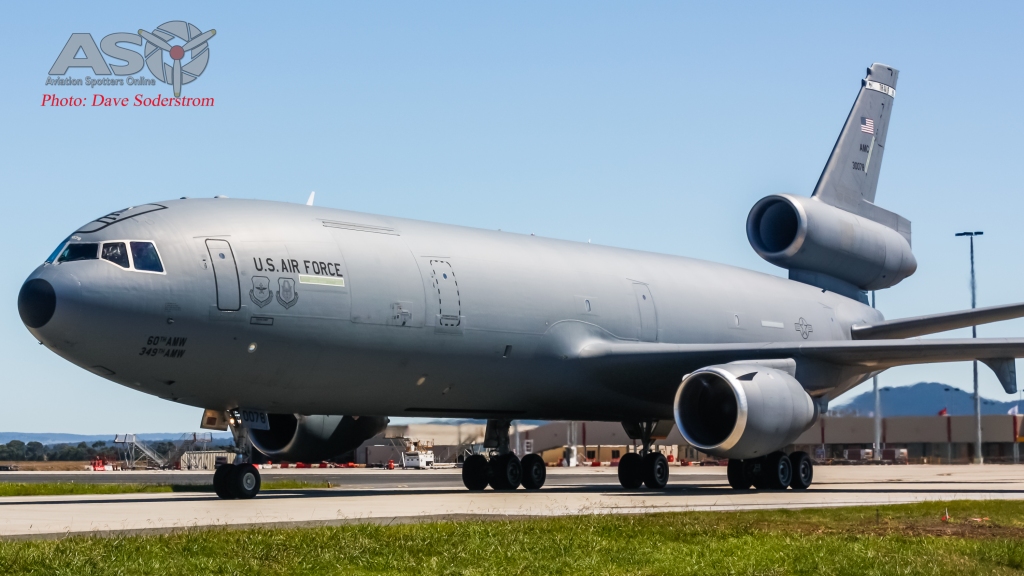
The same aircraft at the 2011 Australian International Airshow in the grey scheme as adopted by AMC, supporting the USAF’s first deployment of its F-22A Raptor aircraft to an Australian airshow.
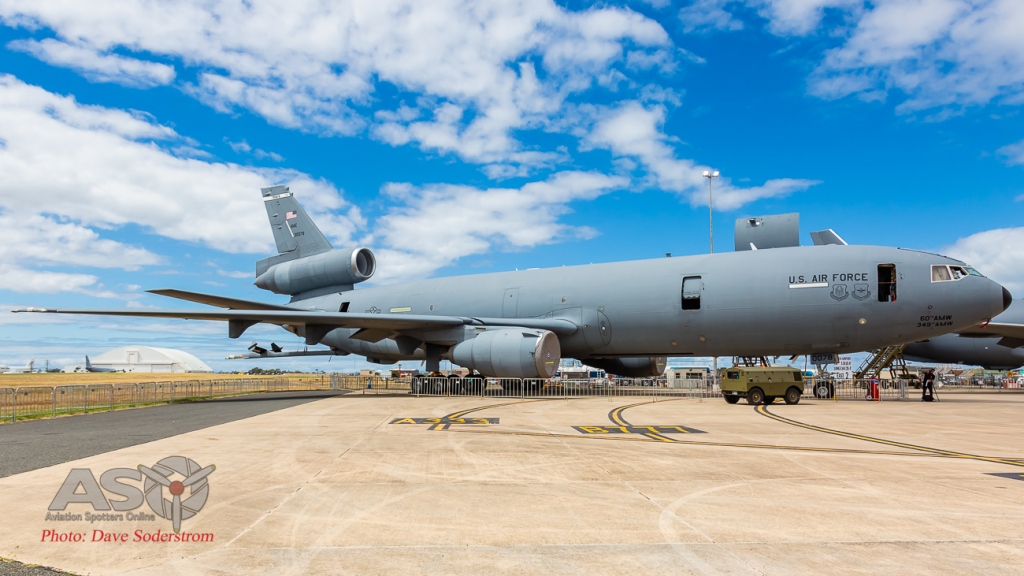
83-0078 sits at the keyhole at Avalon Airshow 2023 where the fantastic crew of the aircraft spent considerable time with the ASO team.
KC-10A Extender Summary.
The USAF was suffering from a shortfall in capability during the ongoing Vietnam War. the Service was relying solely on the Boeing KC-135 Stratotanker to meet its larger global commitments while still using the Korean War-era piston-engined Boeing KC-97s fleet domestically.
The KC-135 fleet was deployed to and from Southeast Asia to support tactical aircraft and strategic bombers like the B-52, F-105, F 1-11, and RC-135D as examples. Then operated as part of the Strategic Air Command, it was clear the task of keeping up with the high tempo of operations in Asia and the needs of the U.S.-based nuclear-bomber fleet were stretching the fleet considerably. In 1972, two Douglas DC-10s were flown in trials at Edwards Air Force Base, simulating air refuelling to check for possible wake issues. Boeing performed similar tests with its proposed 747 version at the same time. At the end of the evaluation, the Douglas aircraft was shown to be the most versatile and best fit for the Air Force and its ability to land on short runways and the use of civilian maintenance facilities should the need arise. It wasn’t until December 1977 however that a formal order was forthcoming. Twelve were initially ordered and was then later amended to 60 aircraft.
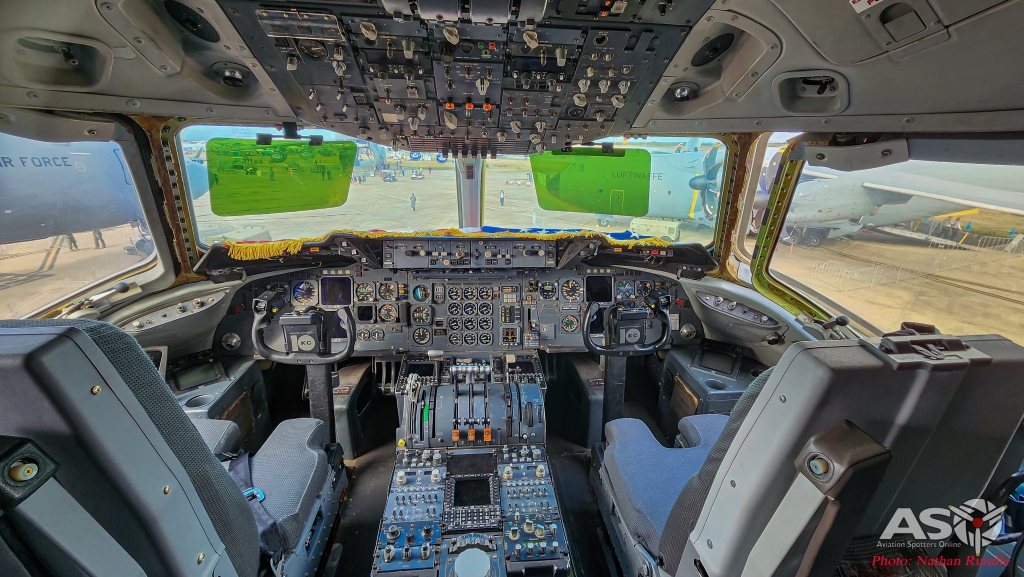
KC-10A Extender Cockpit.
By 1981 the first KC-10A Extender as it was to be known in USAF service was ready for handover. McDonnell Douglas spent considerable time and money to tailor the DC-10 to the KC-10A. Using the basis of the commercial DC-10-30CF (Convertible Freighter) as the version for the conversion to tanker and freighter.
Although the KC-10A retains 88 percent of systems commonality with the DC-10, it has additional systems and equipment necessary for its Air Force mission. These additions include military avionics, the installation of the aerial refuelling boom and aerial refuelling hose and drogue system (which the KC-135 at the time didn’t have) a compartment for the aerial refuelling operator station. The fitting and integration of an aerial refuelling receptacle above the cockpit. And a communications suit for its military missions.

KC-10A 86-0036 in March 2005 at the Avalon Airshow.
McDonnell Douglas designed and built the refuelling boom under a separate contract, which would have been purchased by the Air Force even if the DC-10 was not selected for the role. Known as the Advanced Aerial Refuelling Boom (AARB) it is located on the rear of the aircraft.
An additional refuelling hose drum reel unit is located beside it for probed aircraft. The AARB is operated via a fly-by-wire control. The total fuel capacity for the Extender is some 353,310 lb or 161,508kg this means the Extender is able to refuel fighter jets and other aircraft multiple times and still have enough fuel to return back to base.
When operating in the air-refuelling mission, the Extender can deliver 200,000 lb (90720 kg) of fuel to its receiver aircraft.

Advanced Aerial Refuelling Boom (AARB) is seen partially lowered at the Air Show.
Twenty KC-10s were modified to add wing-mounted pods further enhancing their aerial refuelling capabilities. This capability would allow US Navy and Marines and coalition types to be refuelled by the Air Force should the operational need arise.
Three General Electric CF6-50C2 Turbofans, each producing 23,814kg of thrust, power the KC-10 which enables the aircraft a gross take-off weight of up to 267,619kg and a max speed of 996km/h (0.89 Mach).

In addition to the tanking role, the aircraft also functions as a freighter/transport, thus giving it a true dual role. Designed with an 8ft 6 in x 11ft 8 in (2.59m x 3.56m) cargo loading door on the lefthand side of the airframe. this enables the carrying of 25 pallets with access from both sides or 27 pallets with a single aisle on the starboard side. The main deck will usually feature up to 24 passenger airliner-style seats, allowing cargo to fill the rest.
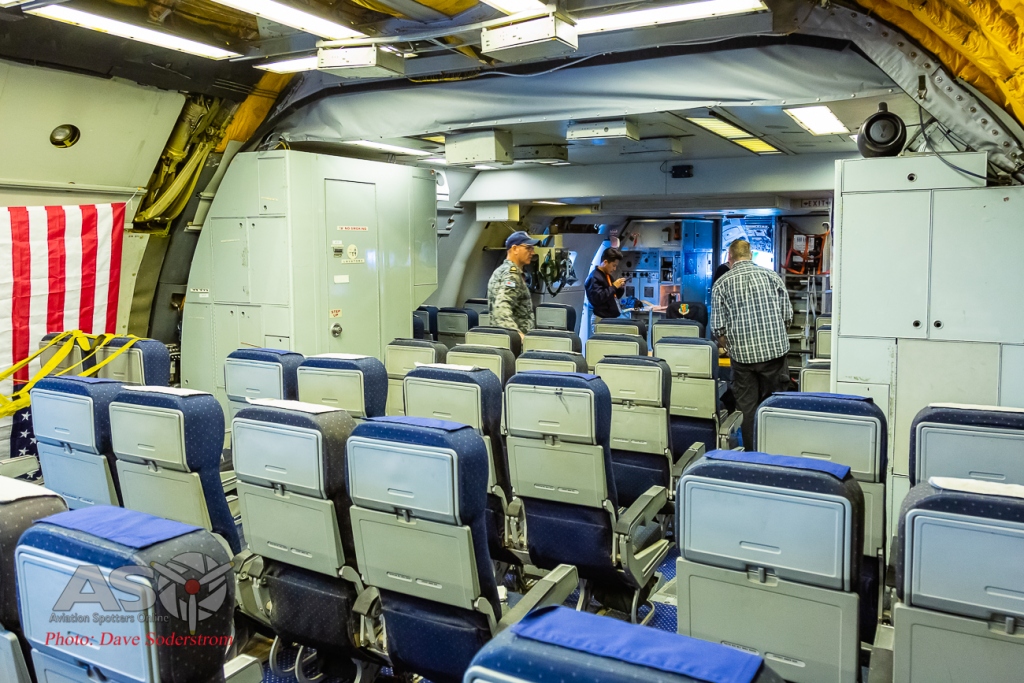
KC-10A cabin with crew seats.
The first KC-10 was delivered to the Air Force’s Strategic Air Command (SAC) in March 1981 at Barksdale AFB. In 1982 a newly renamed 22nd Air Refuelling Wing (formerly the 22nd Bombardment Wing) was re-equipped with KC-10A Extenders and became the 2nd Air Force Unit to operate the new tankers.
KC-10 and the RAAF
Australia while not having operated the KC-10 has seen the type regularly within the country. The first visit of the Extender in Australia was when it was tasked with bringing the first two F/A-18B ‘Classic’ Hornets to Australia from US Naval Station Lemoore in California non-stop to RAAF Williamtown. Arriving on Australian soil on the 17th of May 1985. The 15-hour flight which covered 6,830nm (12,640 km) saw the two Hornets refuel thirteen times, and the Extender itself was refuelled by another Extender over Hawaii. A21-101 and A21-102 arrived in Australia at 16:00hrs thus ushering the RAAF into 4th Generation fighter operations.
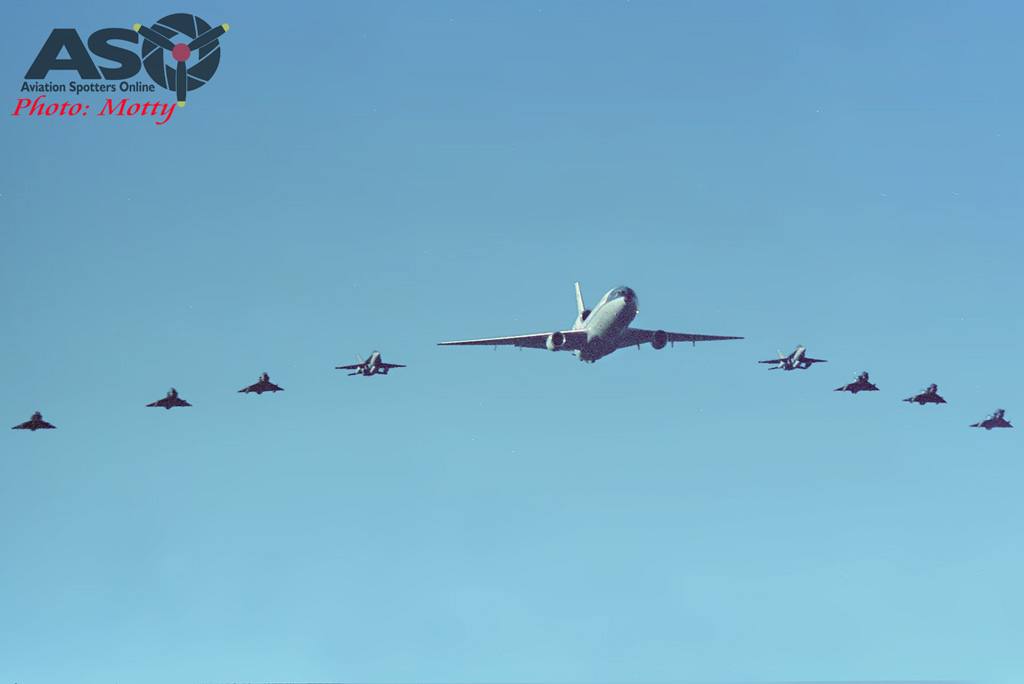
This formation of RAAF Dassault Mirage and F/A-18Bs marks the arrival of the Hornet in Australia thanks in part to the KC-10 which brought them to Australia.

KC-10 83-0078 brings across two RAAF F/A-18B Classic Hornets to Australia on their delivery flight. (ASO Photo archive)

83-0078 airborne with two then brand new RAAF F/A-18B Hornets refuelling them all the way on the delivery flight from the USA. (ASO Image archive)

The KC-10A that brought the first two RAAF F/A-18B Hornets to Australia.

KC-10A lined up as part of the displays at the 1988 Bicentennial Airshow at RAAF Richmond.

KC-10A 86-0036 again when in operation with the 305th AMW and the 514th AMW. This particular airframe is now retired to the Boneyard at Davis Monthan.
The RAAF was never offered the chance to purchase the KC-10. Australia purchased and converted ex-civilian Boeing 707s to serve as air-to-air refuellers. In the early 2000s, McDonnell Douglas offered the MD-11 tanker/transport version of the MD-11CF which had the in-house designation KMD-11. MDC offered either conversion of second-hand aircraft (KMD-11) or new build aircraft (KC-10B), the proposed KMD-11 offered 35,000 lbs more cargo capacity and 8,400 lbs more transferable fuel than the KC-10A. As time would tell the offer was never taken up instead the RAAF ordered the Airbus KC-30A to fulfil the A2A role of the Boeing 707.
Extender Personal Requirements
The Extender operates its mission with a crew of four. This consists of a pilot, co-pilot, flight engineer, and boom operator. Certain missions may require additional crew members, for example when operating aeromedical evacuation missions, a basic crew of five (two flight nurses and three medical technicians) is added.
As the aircraft travelling to Avalon was going so far from its normal base of operations two crews were flown to Australia so as to allow plenty of rest time for the long journey.

Inside the large cargo hold of the main deck of the KC-10 looking aft.
KC-10 Operators through the years.
There has been a large number of operational units that over the years have operated the Extender. Below is a list of all units and their time operating the aircraft and their base locations.
- Strategic Air Command
- 2nd Bomb Wing – Barksdale AFB, Louisiana 1981–1992
- 2d Air Refuelling Squadron 1989–1992
- 32d Air Refuelling Squadron 1981–1992
- 4th Wing – Seymour-Johnson AFB, North Carolina 1991–1992
- 344th Air Refuelling Squadron
- 911th Air Refuelling Squadron
- 22d Air Refueling Wing – March AFB, California 1982–1992
- 6th Air Refuelling Squadron 1989–1992
- 9th Air Refuelling Squadron 1982–1992
- 22d Air Refuelling Squadron 1982–89
- 68th Air Refueling Group/Wing – Seymour-Johnson AFB 1982–1991
- 344th Air Refuelling Squadron 1986–1991
- 911th Air Refuelling Squadron 1982–1991
- 802d Air Refuelling Wing – Lajes Air Base, Azores 1990–1991
- 802d Air Refuelling Squadron
- 1709th Air Refuelling Wing – King Abdul Aziz Air Base, Saudi Arabia 1990–1991
- 1710th Air Refuelling Squadron
- 2nd Bomb Wing – Barksdale AFB, Louisiana 1981–1992
- Air Mobility Command
- 22d Air Refueling Wing – March AFB 1992–1994
- 6th Air Refuelling Squadron
- 9th Air Refuelling Squadron
- 458th Operations Group – Barksdale AFB 1992–1994
- 2d Air Refuelling Squadron
- 32d Air Refuelling Squadron
- 4th Operations Group – Seymour-Johnson AFB 1992–1995
- 344th Air Refuelling Squadron 1992-1994
- 711th Air Refueling Squadron 1994-1994
- 744th Air Refuelling Squadron 1994-1995
- 911th Air Refuelling Squadron 1992-1994
- 60th Air Mobility Wing – Travis AFB, California 1994–present
- 6th Air Refuelling Squadron 1995–present
- 9th Air Refuelling Squadron 1994–present
- 305th Air Mobility Wing – McGuire AFB, New Jersey 1994–present
- 2d Air Refuelling Squadron 1994-2021
- 32d Air Refuelling Squadron
- 380th Air Expeditionary Wing – Al Dhafra Air Base, United Arab Emirates 2002–present
- 908th Expeditionary Air Refuelling Squadron
- 722d Air Refueling Wing – March AFB 1994–1996
- 6th Air Refuelling Squadron 1994–1996
- 9th Air Refuelling Squadron 1994
- 22d Air Refueling Wing – March AFB 1992–1994
- Air Force Reserve Command
- 98th Air Refuelling Group (Associate) – Barksdale AFB 1987–1994
- 78th Air Refuelling Squadron
- 452d Air Refuelling Wing (Associate) – March AFB 1981–1995
- 78th Air Refuelling Squadron 1981–1987
- 79th Air Refuelling Squadron 1982–1995
- 349th Air Mobility Wing (Associate) – Travis AFB 1994–present
- 70th Air Refuelling Squadron 1994–present
- 79th Air Refuelling Squadron 1995–present
- 514th Air Mobility Wing (Associate) – McGuire AFB 1994–present
- 76th Air Refuelling Squadron 1994-2022
- 78th Air Refuelling Squadron
- 916th Air Refueling Group (Associate) – Seymour-Johnson 1985–1994
- 77th Air Refuelling Squadron
- 98th Air Refuelling Group (Associate) – Barksdale AFB 1987–1994
KC-10 in-flight refuelling
As the Extender does its role of transport and logistics, it’s the air-to-air refuelling that grabs the attention and the imagination of those who admire her. It would be impossible to put together a list of all the various types that have refuelled from the Extender over the years however, thanks to the USAF and its images library we have a few of theirs to go along with some of ours and we thought it was time to look at the endurance the KC-10 brought to other types.


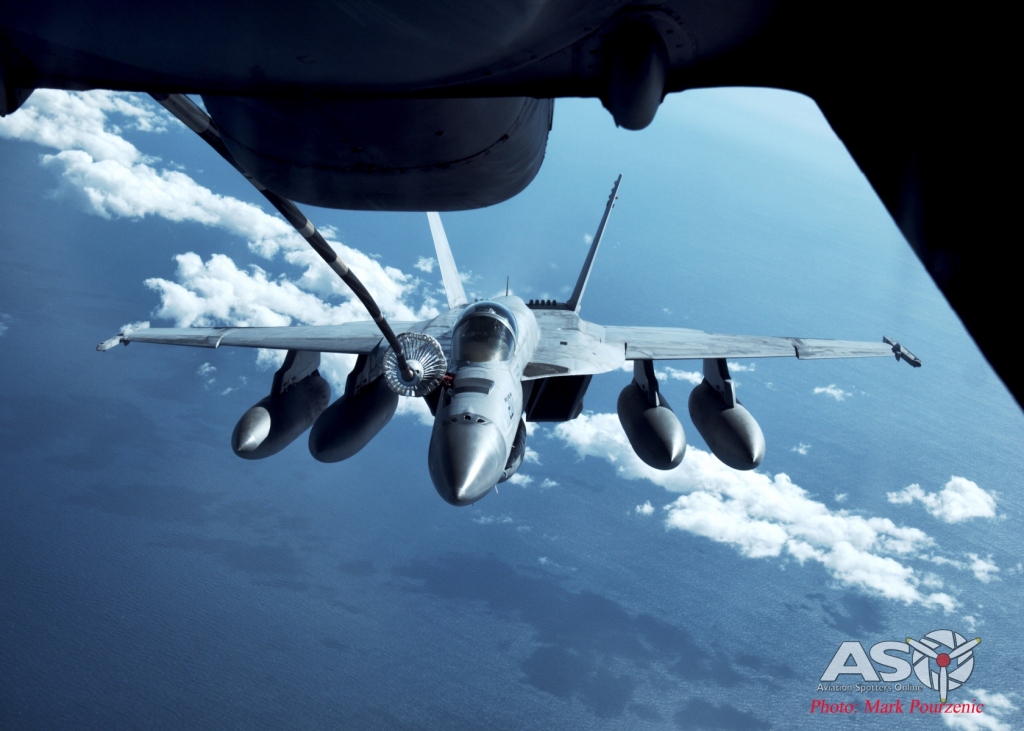
US Navy F/A-18E Super Hornet from VFA-27 refuelling from the KC-10 during Talisman Sabre 2019.
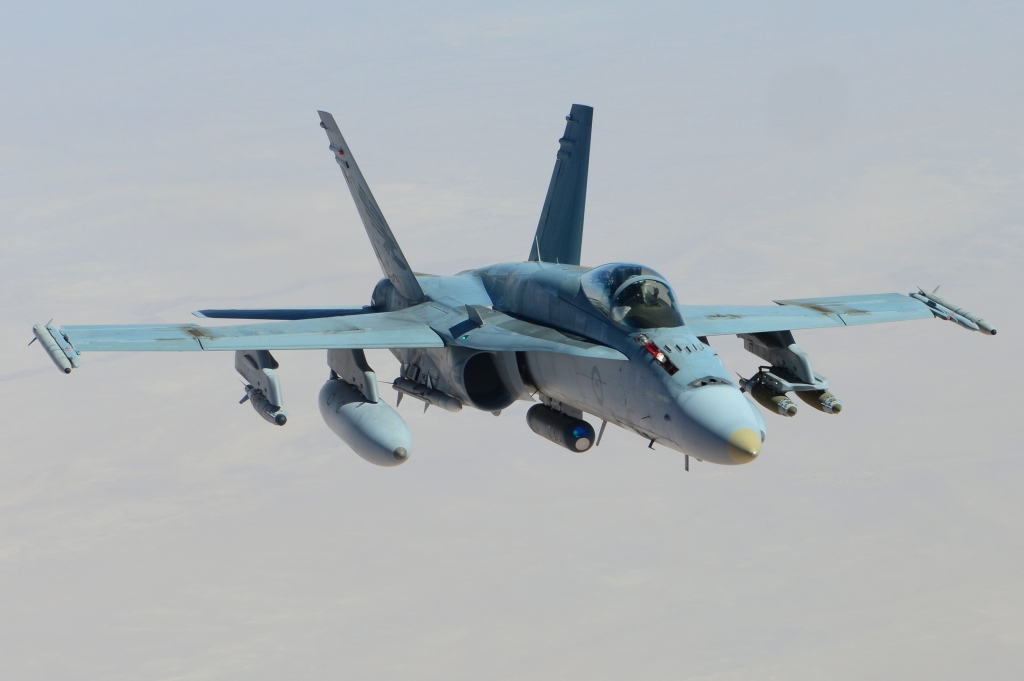
A bomb-laden Royal Australian Air Force (RAAF) F/A-18A Hornet multi-role fighter aircraft approaches a United States Air Force (USAF) KC-10 Extender air-to-air refuelling aircraft during a mission over Iraq. Air-to-air refuelling is essential for ensuring the F/A-18As can remain on station for as long as possible to conduct close air support and precision strike operations in support of Iraqi Security Forces. (US Air Force Image)
OPERATION IRAQI FREEDOM — A KC-10A Extender refuels an F-15E Strike Eagle on a combat patrol over Iraq. The aircraft are part of the 380th Air Expeditionary Wing at a forward-deployed location. The KC-10As are from the 305th Air Mobility Wing at McGuire Air Force Base, N.J., and the F-15Es are from the 48th Fighter Wing at Royal Air Force Lakenheath, England. (U.S. Air Force photo by Maj. Robert Couse-Baker)
A U.S. Air Force E-3 Sentry flies over the U.S. Central Command area of responsibility on Feb. 1, 2021. The E-3 Sentry is an airborne warning and control system aircraft with an integrated command and control battle management surveillance, target detection and tracking platform. (U.S. Air Force photo by Staff Sgt. Sean Carnes)
OPERATION ENDURING FREEDOM — A KC-10A Extender with the 380th Air Expeditionary Wing lowers its flying boom to provide fuel to an approaching B-52H Stratofortress over Southwest Asia (U.S. Air Force Photo by Chaplain (Lt. Col.) Redmond Raux)
A U.S. Air Force KC-10 Extender assigned to the 908th Expeditionary Air Refuelling Squadron flies over an undisclosed location in the U.S. Central Command area of responsibility, on Nov. 10, 2022. The KC-10 delivers global aerial refuelling capability to support joint and coalition aircraft, providing war-winning airpower throughout the CENTCOM area of responsibility. (U.S. Air Force photo by Staff Sgt. Gerald R. Willis)
A KC-10 Extender from the 6th Air Refuelling Squadron, Travis AFB, Calif., refuels a CV-22 Osprey from the 20th Special Operations Squadron, Cannon Air Force Base, N.M., during an aerial refuelling training mission over New Mexico, March 11, 2019. Travis AFB Airmen fly training missions regularly to stay current and be prepared for future mobility operations. (U.S. Air Force photo by Master Sgt. Joseph Swafford)
060725-F-2034C-015A B-2 Spirit is refuelled by a KC-10 over Australia during exercise Green Lighting July 25, 2006. The KC-10 and B-2 are from the 36th Expeditionary Wing, Guam. The exercise will improve the U.S. capabilities and operational familiarity in the region for the Pacific bomber presence and servers to enhance relations with the Australians. (U.S. Air Force photo/ Tech. Sgt. Shane A. Cuomo)
A French Mirage 2000 is refuelled by a 908th Expeditionary Air Refuelling Squadron KC-10A Extender during a multinational exercise, on Dec. 6, 2009, in Southwest Asia. Aircrews from France, Jordan, Pakistan, the U.K., and the U.S. trained together in the U.S. Air Forces Central area of responsibility in fighting a large-scale air war. (U.S. Air Force photo/Staff Sgt. Michael B. Keller)
An EA-6 Prowler refuels from the drogue of a KC-10 Extender, July 18, 2006. The KC-10 is part of the 908th Expeditionary Air Refuelling Squadron, Southwest Asia. (U.S. Air Force photo/Senior Airman Brian Ferguson)
A German Tornado GR-4 receives fuel from a KC-10 Extender during a mission in support of Combined Joint Task Force-Operation Inherent Resolve over Iraq, Feb. 22, 2017. The KC-10 offloaded 126,000 pounds of fuel to multinational coalition aircraft working to weaken and destroy the Islamic State of Iraq and Syria operations in the Middle East region and around the world. (U.S. Air Force photo/Senior Airman Tyler Woodward)
An F-16 Fighting Falcon showing the aggressor paint scheme disconnects from a KC-10 Extender after being refuelled during a Red Flag-Alaska exercise on April 22 and is ready to re-engage the friendly forces. The F-16 is from the 18th Aggressor Squadron at Eielson Air Force Base, Alaska. (U.S. Air Force photo/Senior Airman Jonathan Snyder)
An E-4B from Global Strike Command, Barksdale Air Force Base, La., is refuelled by a KC-10 Extender from Travis AFB, Calif., during a local mission on June 12, 2017. In case of national emergency or destruction of ground command and control centres, the E-4B provides a highly survivable command, control and communications centre to direct U.S. forces, execute emergency war orders and coordinate actions by civil authorities. (U.S. Air Force photo by Staff Sgt. Nicole Leidholm)
SOUTHWEST ASIA (AFPN) — A Navy F-14 Tomcat refuels over Iraq at sunset from a KC-10 Extender aircraft assigned to the 908th Expeditionary Refuelling Squadron. The F-14 is supporting Operation Iraqi Freedom. (U.S. Air Force photo by Tech. Sgt. Mike Hammonds)
A 37th Tactical Fighter Wing F-117A stealth fighter aircraft refuels from a 22nd Air Refuelling Wing KC-10 Extender aircraft during Operation Desert Shield. The F-117A is en route to Saudi Arabia.
Royal Air Force pilots from the 6 Squadron flying the Eurofighter Typhoon get a rare opportunity to refuel from a KC-10 Extender piloted by Air Force Reserve aircrew stationed at Joint Base McGuire-Dix-Lakehurst, N.J, June 6, along a track near RAF Leuchars, United Kingdom. The training event took place on the 70th Anniversary of the allied invasion of Normandy, France during World War II. (U.S. Air Force photo/Master Sgt. Donna T. Jeffries)
A U.S. Air Force KC-10 Extender from the 908th Expeditionary Arial Refuelling Squadron refuels a U.S. Navy F/A-18 Super Hornet in Afghanistan on Dec. 11 2008. (cleared for release)(Photo by Staff Sgt. Aaron Allmon)
An F-35A Lightning II conducts aerial refuelling with a KC-10 Extender from the 908th Expeditionary Air Refuelling Squadron, on June 20, 2019, within U.S. Central Command’s area of responsibility. The fifth-generation fighter aircraft provides the pilot with comprehensive situational awareness in a sphere around the aircraft for missile and aircraft warnings, day and night vision, extended range detection and precision targeting against air and ground threats, granting the U.S. Air Force and its allies’ air superiority. (U.S. Air Force photo by Staff Sgt. Keifer Bowes)
An A-10 Thunderbolt II assigned to Moody Air Force Base, Ga., flies below a KC-10 Extender assigned to Travis AFB, Calif., after receiving fuel over California, June 30, 2022. The A-10 participated in Exercise Green Flag-West 22-08. Green Flag-West is a close air support and joint exercise administered by the U.S. Air Force Air Warfare Center and Nellis AFB through the 549th Combat Training Squadron. (U.S. Air Force photo by Master Sgt. Traci Keller)

An Australian F/A-18A Hornet is seen refuelling from a USAF KC-10 tanker during coalition operations in the Middle East Region.

United States Air Force, Pacific Air Force’s KC-135 Stratotanker aircraft refuels a KC-10 Extender aircraft during the ferry of No. 6 Squadron EA-18G Growlers to the United States for Exercise Distant Frontier 21 ahead of Exercise Red Flag Alaska 21-3.
KC-10 refuelling operations in its twilight
The Extender fleet has seen constant use and at a high tempo effectively since the Gulf War. Seeing service in all combat zones including Operations Desert Shield and Desert Storm 46 of the total fleet of 59 being operated in the combat zone. Libya, Yugoslavia, and Kosovo also saw KC-10s operating in support of operations in these areas. Since the attacks on US soil on the 11t September 2001, KC-10s had also flown more than 350 missions guarding U.S. skies as a part of Operation Noble Eagle. During Operations Enduring Freedom and Iraqi Freedom, KC-10s have flown more than 1,390 missions delivering critical air refuelling support to numerous joint and Coalition receiver aircraft including RAAF Hornets stationed in the area of operations.
Currently, the KC-10A Extender fleet is operated by the 305th Air Mobility Wing at Joint Base McGuire-Dix-Lakehurst, N.J.; and the 60th Air Mobility Wing, Travis Air Force Base, Calif. Air Force Reserve Associate units are assigned to the 349th Air Mobility Wing at Travis and the 514th Air Mobility Wing at JB McGuire-Dix-Lakehurst.
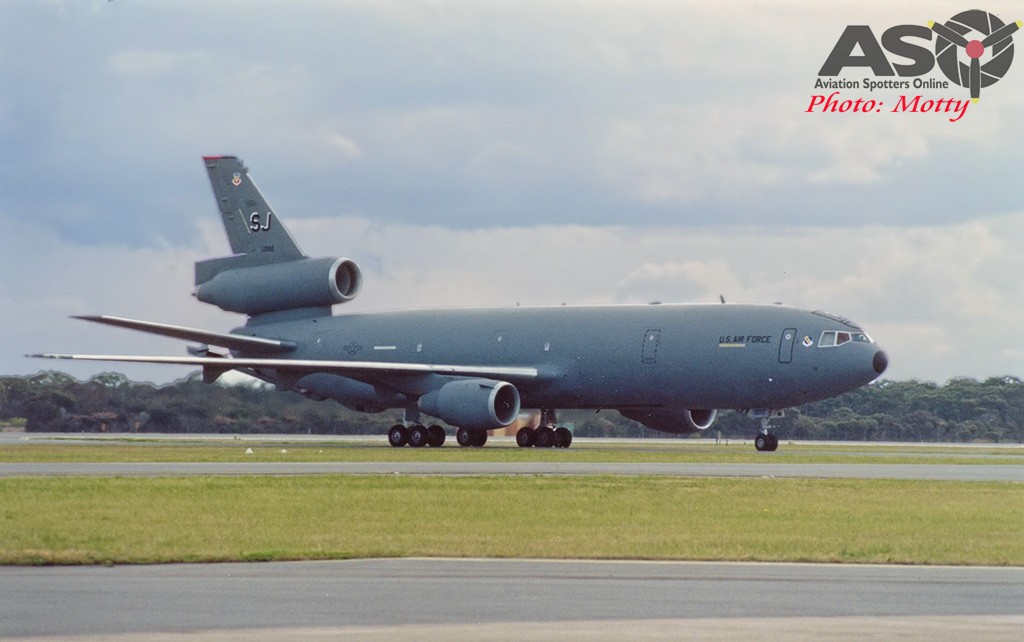
916th Air Refuelling Group KC-10 based at Seymour-Johnson operated the type between 1985–1994 as part of the 77th Air Refuelling Squadron.
Since 2020 the USAF has begun the drawdown and retirement of the legacy tanker fleet as the newer Boeing KC-46A enters service in larger numbers. The first to arrive at the Davis Monthan for storage was serial 86-0036. By the end of 2022, this has risen to 26. Twelve more will depart in 2023. Travis AFB will officially fly its last KC-10 in September 2024.
There are currently two operators of the Extender this being the 6th Air Refuelling Squadron (6 ARS) is part of the 60th Air Mobility Wing at Travis Air Force Base, California. It continues to operate the Extender in support of the USAF. Travis AFB is located in Northern California nested between the San Francisco Bay and the state capitol, Sacramento.
The other operator of the Extender is the 305th Air Mobility Wing, a United States Air Force strategic airlift and air refuelling wing under the operational control of the Air Mobility Command. It generates, mobilizes and deploys C-17 Globemaster III and KC-10 Extender aircraft. The 32d received the first KC-10A delivered to the Air Force, at Barksdale AFB, on 17 March 1981. 
The 305th is no stranger to Australia. During Talisman Sabre ASO was given access on a flight with the USAF on the KC-10. Click the link here to read more: http://aviationspottersonline.com/exercise-talisman-sabre-2019-usaf-mcdonnell-douglas-kc-10a-extender-media-flight/
6th Air Refueling Squadron Story so far.
Once the Squadron had trained up on the B-29 Superfortress, they deployed to North Field, Guam, where they became a component of the 314th Bombardment Wing of XXI Bomber Command. The Squadrons’ first combat mission was to attack Tokyo in February of 1945, with their missions, in the beginning, being that of high altitude attacks against strategic targets, progressing to low altitude night raids, using incendiaries in the final push towards the surrender of Japan and saw the Squadron disband once again in Guam during March 1946.

KC-10A 84-0187 departs Perth Airport
The intervening years between 1947 saw the squadron fall under the Air Force Reserve at Barksdale Field, Louisiana, before inactivation in 1949. The 6th Air Refuelling Squadron was activated in April 1951 at Walker Air Force Base, New Mexico, to begin training with the Boeing KB-29 tanker version of the Superfortress.
The squadron’s tenure with the 6thBG was relatively short, as the group was in the process of converting to the Convair B-36 Peacemaker which lacked any air refuelling capability, requiring the Squadron inactive yet again. During 1957, the 6th Bombardment Wing had transitioned to the Boeing B-52B Stratofortress, which necessitated the need for air refuelling aircraft, activating the 6th Air Refuelling Squadron once again at Bergstrom Air Force Base, Texas during the latter half of 1957. This came after SAC had realigned its 27th Strategic Fighter Wing (27thFW) over to the Tactical Air Command (TAC), relinquishing its fighter aircraft, as the need for fast jet fighter bomber escorts was deemed unnecessary with the introduction of the Boeing B-47 and B-52 jet engine bombers, whilst retaining the 27th’s Air Refuelling Squadron that was absorbed into the 6thARS.
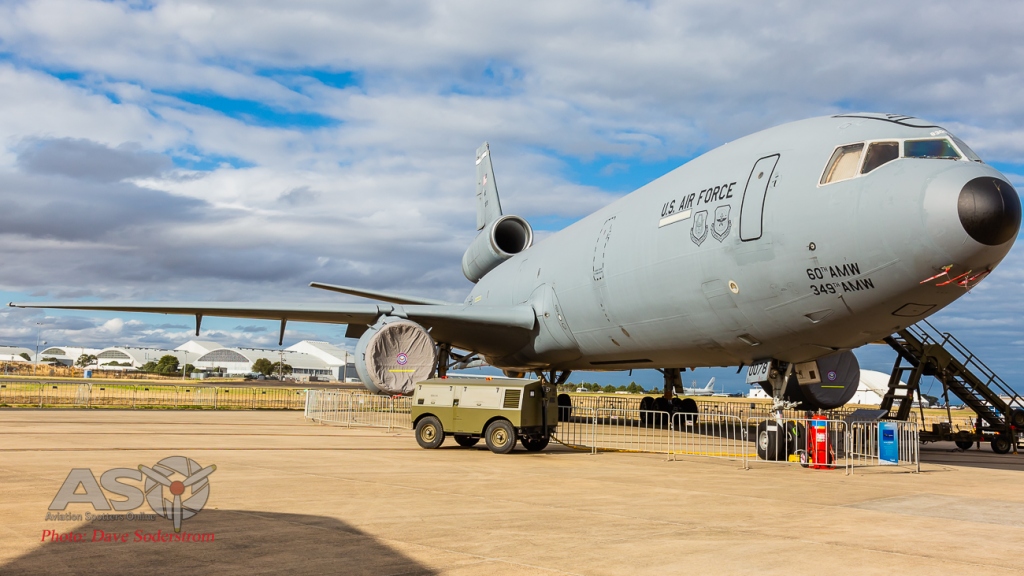

The 6th Air Refuelling Squadron literally rolling out the welcome mat.




In summary

The last time Australia sees a KC-10?








